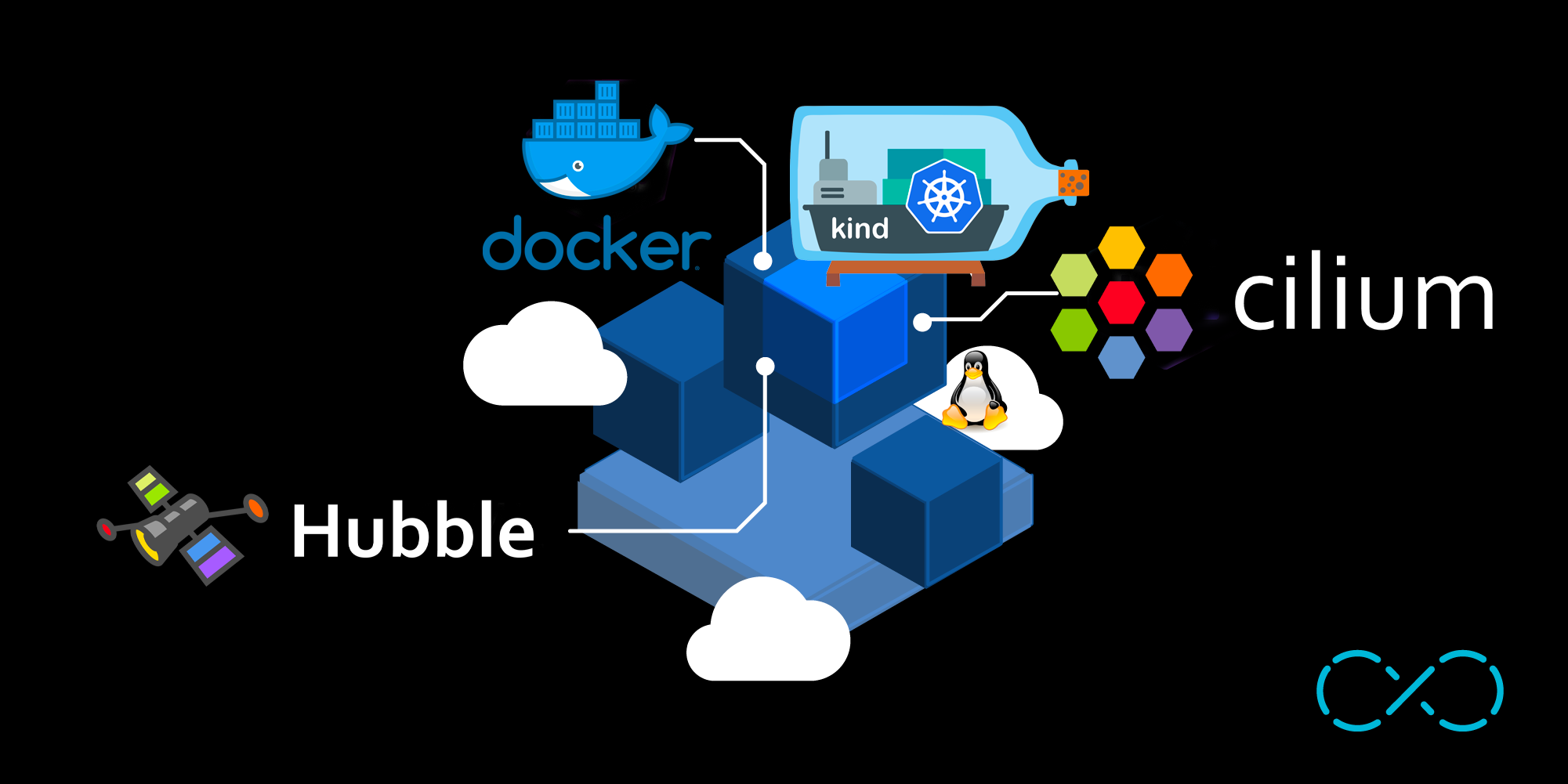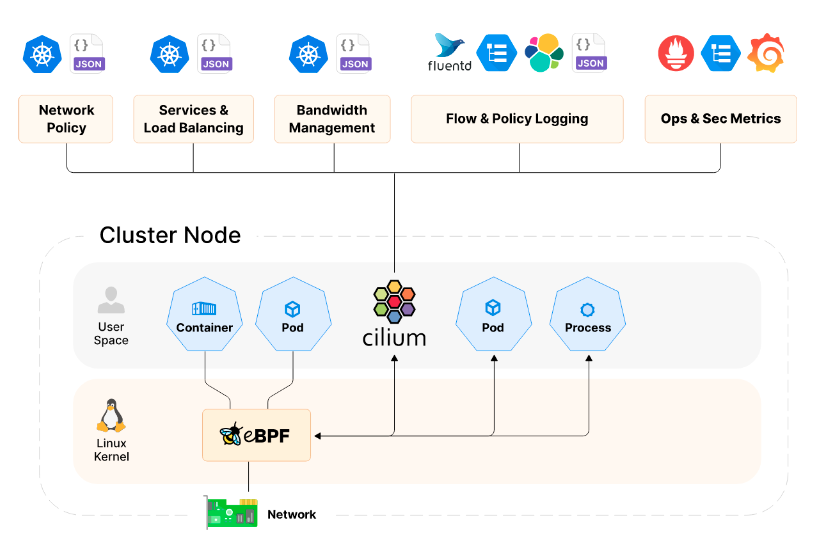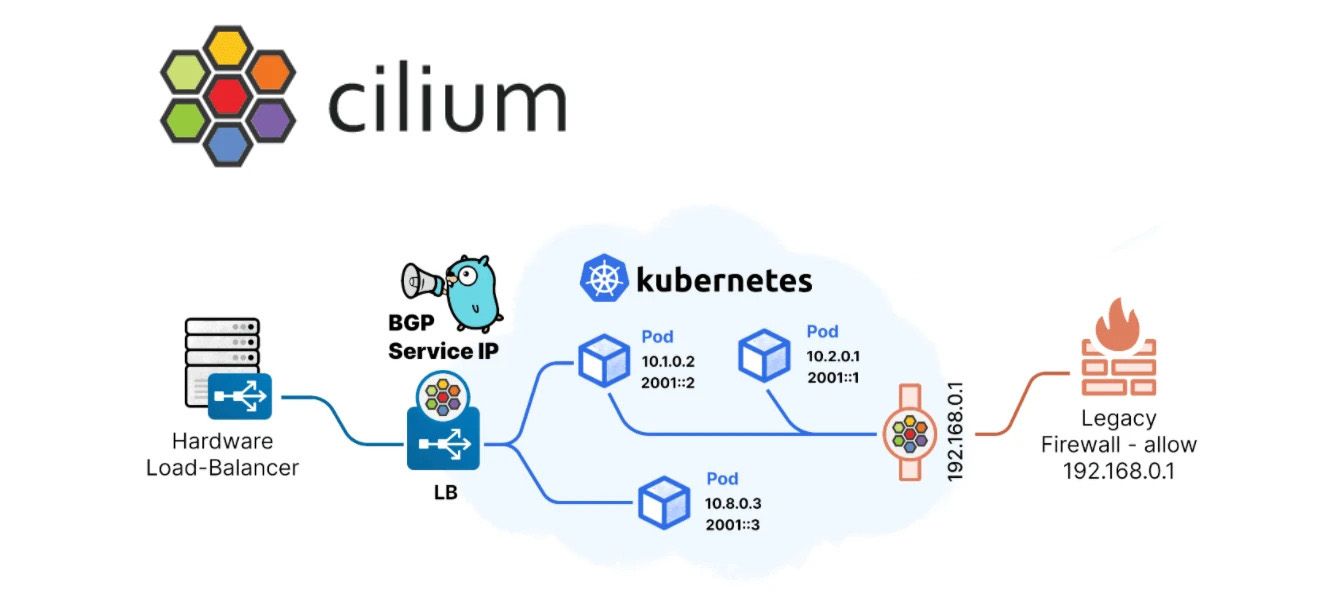
This guide walks you through setting up a local Kubernetes cluster using Kind and Cilium for advanced networking and observability.
🚀 Why Kind?
Kind is a tool for running local Kubernetes clusters using Docker containers. It is primarily used for development, testing, and learning Kubernetes.
What is Kind Used For?
- Local Development and Testing: Ideal for creating Kubernetes clusters on a local machine.
- Speed and Lightweight: Uses Docker containers to simulate Kubernetes nodes, making it fast and resource-efficient.
- Compatibility: Supports recent versions of Kubernetes, allowing you to test advanced features or multi-node configurations.
How Does Kind Work?
Kind creates each Kubernetes node as a Docker container. It uses a special Docker image, called a node image, which contains all the components needed to run a Kubernetes node (e.g., kubelet, containerd).
Typical Use Cases
- Testing Applications: Deploy and test applications in a local Kubernetes environment before moving them to production.
- Developing Kubernetes Operators: Often used to develop and test Kubernetes operators.
- Learning Kubernetes: Perfect for practicing Kubernetes operations without needing a cloud environment.
- Continuous Integration (CI): Integrated into CI pipelines to run tests on ephemeral Kubernetes clusters.
- No Cloud Costs – Everything runs locally, avoiding cloud infrastructure expenses.
- Reproducible – Easily reset and redeploy clusters for testing.
- Multi-node Support – Test distributed workloads and cluster topologies locally.
🐝 Why Cilium?
Cilium is a modern Container Network Interface (CNI) that leverages eBPF (extended Berkeley Packet Filter) technology for providing high-performance networking, security, and observability in cloud-native environments. Some of the key advantages of using Cilium include:
- Enhanced Security: Cilium offers advanced security features, including identity-based policies and layer 7 traffic filtering, allowing for fine-grained control over microservices communication.
- Performance Efficiency: By utilizing eBPF, Cilium can achieve more efficient networking by processing data at the kernel level, reducing overhead and improving overall throughput.
- Visibility and Monitoring: Cilium provides deep visibility into network traffic, helping to monitor and troubleshoot application performance with features such as packet capture and real-time metrics.
- Support for Cloud-Native Architectures: Designed specifically for Kubernetes and cloud-native applications, Cilium integrates seamlessly with existing workloads while also supporting service mesh architectures.
- Dynamic Load Balancing: Cilium offers built-in load balancing capabilities that are based on real-time traffic patterns, enhancing the responsiveness and reliability of applications.
In summary, incorporating Cilium as your CNI brings significant performance and security benefits that are essential for modern, scalable cloud-native applications.

📋 Prerequisites
– Installed Docker (Engine), Podman, or nerdctl
- Installed kubectl (command line tool for Kubernetes API)
🛠️ Kind installation
There are several options to install Kind. If you are a Go developer, the Go installation method might suit you well. Otherwise, pre-compiled binaries are available for download, along with packages managed by the community.
We will choose the binary installation option. Our host is an ARM64 Linux machine.
[ $(uname -m) = aarch64 ] && curl -Lo ./kind https://kind.sigs.k8s.io/dl/v0.29.0/kind-linux-arm64
chmod +x ./kind
sudo mv ./kind /usr/local/bin/kind📦 Creating a Cluster
We will create a KIND cluster with four nodes: one control-plane and three workers. The default CNI installation will be disabled so we can install Cilium later. We will also set the cluster’s local domain — in this example, k8sdemos2.local — and define the pod and service subnets.
The configuration file :
#kind-config.yaml
kind: Cluster
apiVersion: kind.x-k8s.io/v1alpha4
name: k8sdemos2
nodes:
- role: control-plane
- role: worker # worker1
- role: worker # worker2
- role: worker # worker3
networking:
disableDefaultCNI: true
podSubnet: "10.10.0.0/16"
serviceSubnet: "10.11.0.0/16"
apiServerPort: 6443
kubeadmConfigPatches:
- |
apiVersion: kubeadm.k8s.io/v1beta3
kind: ClusterConfiguration
networking:
dnsDomain: "k8sdemos2.local"Create a cluster:
kind create cluster --config kind-config.yaml
Ensuring node image (kindest/node:v1.33.1) 🖼
✓ Preparing nodes 📦 📦 📦
...........
✓ Starting control-plane 🕹️
✓ Installing StorageClass 💾
✓ Joining worker nodes 🚜
Set kubectl context to "kind-k8sdemos2"
You can now use your cluster with:
kubectl cluster-info --context kind-k8sdemos2After a few minutes, the cluster will be operational.
After the cluster is created, we will label the worker nodes appropriately:
kubectl label node k8sdemos2-worker node-role.kubernetes.io/worker=worker
kubectl label node k8sdemos2-worker2 node-role.kubernetes.io/worker=worker
kubectl label node k8sdemos2-worker3 node-role.kubernetes.io/worker=workerVerify the node status :
kubectl get nodes
NAME STATUS ROLES AGE VERSION
k8sdemos2-control-plane NotReady control-plane 5m v1.33.1
k8sdemos2-worker NotReady worker 5m v1.33.1
k8sdemos2-worker2 NotReady worker 5m v1.33.1
k8sdemos2-worker3 NotReady worker 5m v1.33.1The nodes are in a ‘NotReady’ state because the CNI installation is disabled in the KinD config file, where ‘disableDefaultCNI’ is set to true. This means that the essential networking layer required for pod communication and cluster operation is not configured. Consequently, the kubelet reports a “NotReady” state as it cannot establish network connectivity. Without CNI, pods cannot be assigned IP addresses.
🌐 Cilium Installation
Install the Cilium CLI
Install the latest version of the Cilium CLI. The Cilium CLI can be used to install Cilium, inspect the state of a Cilium installation, and enable/disable various features .
On Linux:
CILIUM_CLI_VERSION=$(curl -s https://raw.githubusercontent.com/cilium/cilium-cli/main/stable.txt)
CLI_ARCH=amd64
if [ "$(uname -m)" = "aarch64" ]; then CLI_ARCH=arm64; fi
curl -L --fail --remote-name-all https://github.com/cilium/cilium-cli/releases/download/${CILIUM_CLI_VERSION}/cilium-linux-${CLI_ARCH}.tar.gz{,.sha256sum}
sha256sum --check cilium-linux-${CLI_ARCH}.tar.gz.sha256sum
sudo tar xzvfC cilium-linux-${CLI_ARCH}.tar.gz /usr/local/bin
rm cilium-linux-${CLI_ARCH}.tar.gz{,.sha256sum}We will install Cilium into the Kubernetes cluster referenced by the current kubectl context, using a custom configuration file (ciliumValues.yaml) to enable specific networking, observability. In this example, we specify the Cilium version (1.18.0) and pass our configuration file to the installer:
cilium install --version 1.18.0 -f ciliumValues.yaml --context kind-k8sdemos2The configuration enables kubeProxyReplacement, custom IPAM settings, Hubble observability (including the UI and relay), Layer 2 announcements.
Below is the configuration used:
# ciliumValues.yaml
kubeProxyReplacement: true
hostServices:
enabled: false
externalIPs:
enabled: true
nodePort:
enabled: true
hostPort:
enabled: true
image:
pullPolicy: IfNotPresent
ipam:
mode: kubernetes
hubble:
enabled: true
metrics:
enableOpenMetrics: true
relay:
enabled: true
ui:
enabled: true
peerService:
clusterDomain: k8sdemos2.local
l2announcements:
enabled: true
leaseDuration: "3s"
leaseRenewDeadline: "1s"
leaseRetryPeriod: "500ms"
cluster:
name: kind-k8sdemos2
In this setup, Cilium manages LoadBalancer IP addresses using its built-in LB IPAM feature.
Instead of relying on an external load balancer, Cilium assigns IPs directly to Kubernetes Service objects of type LoadBalancer from the configured address pools.
We enable Layer 2 (L2) announcements so that each node hosting a LoadBalancer service will broadcast (via ARP/NDP) the ownership of the assigned IP on the local network. This allows clients on the same Layer 2 network to reach the service without additional routing configuration.
In our configuration:
l2announcements.enabled: trueactivates the feature.leaseDuration,leaseRenewDeadline, andleaseRetryPeriodcontrol the timing for leader election and IP ownership refresh between nodes.- This setup is particularly useful for bare-metal or Kind/Docker-based test clusters, where you want external connectivity for LoadBalancer services without deploying MetalLB or a cloud-specific load balancer.
sequenceDiagram
participant User as External Client
participant LB as LoadBalancer IP
participant Node as Kubernetes Node
participant Cilium as Cilium Agent
participant Pod as Service Pod
User->>LB: Connect to LoadBalancer IP
LB->>Node: Traffic arrives at Node (any node in cluster)
Node->>Cilium: Cilium intercepts traffic
Cilium->>Pod: Cilium routes traffic to correct Service Pod
Note over Cilium: Cilium announces the LoadBalancer IP<br>using ARP/NDP on the network,<br>making it reachable from outside
Pod-->>User: Service response returned via Cilium and Node
%% Explanation:
%% - Cilium assigns and announces the LoadBalancer IP on the network using ARP/NDP.
%% - External clients can reach the service via the LoadBalancer IP.
%% - Cilium ensures traffic is routed to the correct pod, regardless of which node receives the traffic.
The assigned IP will be advertised on the Layer 2 network by the node running the service endpoint, making it directly reachable from your local machine or other devices on the same subnet.
You may be seeing cilium install print something like this:
🔮 Auto-detected Kubernetes kind: kind
ℹ️ Using Cilium version 1.18.0
.....To validate that Cilium has been properly installed, you can run :
:> cilium status --wait
/¯¯\
/¯¯\__/¯¯\ Cilium: OK
\__/¯¯\__/ Operator: OK
/¯¯\__/¯¯\ Hubble Relay: OK
\__/¯¯\__/ ClusterMesh: disabled
\__/
DaemonSet cilium Desired: 2, Ready: 2/2, Available: 2/2
Deployment cilium-operator Desired: 2, Ready: 2/2, Available: 2/2
Containers: cilium-operator Running: 2
cilium Running: 2
Image versions cilium quay.io/cilium/cilium:v1.8.0: 2
cilium-operator quay.io/cilium/operator-generic:v1.8.0: 2This command will display the live deployment status of various Cilium components.
Afterwards, running kubectl get nodes will display the nodes in a ready state, confirming the successful setup of networking with Cilium :
NAME STATUS ROLES AGE VERSION
k8sdemos2-control-plane Ready control-plane 20m v1.33.1
k8sdemos2-worker Ready worker 20m v1.33.1
k8sdemos2-worker2 Ready worker 20m v1.33.1
k8sdemos2-worker3 Ready worker 20m v1.33.1Congratulations 👏 ! You have a fully functional Kubernetes cluster with Cilium.
LoadBalancer IPAM & Layer 2 Announcements in Cilium
Cilium’s LoadBalancer IPAM feature supports the concept of IP address pools.
An administrator can define one or more pools to explicitly control which IP ranges Cilium is allowed to allocate for Kubernetes LoadBalancer services.

A basic IP pool definition typically includes:
- An IPv4 range
- Optionally, an IPv6 range
When a Service of type LoadBalancer is created, Cilium automatically assigns an available IP from the configured pool.
Our Docker Network Context
On the Docker host we run KIND in the bridge network 172.18.0.0/16
(ip route shows 172.18.0.0/16 dev br-... src 172.18.0.1), and inside a
node the default route is default via 172.18.0.1 dev eth0.
Therefore, LoadBalancer IPs must come from 172.18.0.0/16 so that nodes
can claim/announce them on that bridge.
Shown on the host machine:
ip route
default via 10.0.0.1 dev enp0s9 proto dhcp src 10.0.0.181 metric 100
10.0.0.0/24 dev enp0s9 proto kernel scope link src 10.0.0.181 metric 100
10.0.20.0/24 dev enp1s0 proto kernel scope link src 10.0.20.10 metric 101
169.254.0.0/16 dev enp0s9 proto dhcp scope link src 10.0.0.181 metric 100
172.17.0.0/16 dev docker0 proto kernel scope link src 172.17.0.1 linkdown
172.18.0.0/16 dev br-93cba07bd06c proto kernel scope link src 172.18.0.1
172.19.0.0/16 dev br-3ea92b67e988 proto kernel scope link src 172.19.0.1 linkdownEach node inside the cluster sees this Docker network as its primary interface (eth0) and has routes to all pod subnets on other nodes via Cilium:
docker exec -it k8sdemos2-worker ip route
default via 172.18.0.1 dev eth0 mtu 1450
10.10.0.0/24 via 10.10.3.209 dev cilium_host proto kernel src 10.10.3.209 mtu 1450
10.10.1.0/24 via 10.10.3.209 dev cilium_host proto kernel src 10.10.3.209 mtu 1450
10.10.2.0/24 via 10.10.3.209 dev cilium_host proto kernel src 10.10.3.209 mtu 1450
10.10.3.0/24 via 10.10.3.209 dev cilium_host proto kernel src 10.10.3.209
10.10.3.209 dev cilium_host proto kernel scope link
172.18.0.0/16 dev eth0 proto kernel scope link src 172.18.0.4The default route points to the gateway 172.18.0.1 via eth0, meaning any traffic not matching a more specific route is sent out of the Docker network through this gateway.
Why the Address Pool Matters
For LoadBalancer services to be reachable from outside the cluster: • The IPs assigned by Cilium must be within the Docker network range (172.18.0.0/16) so that nodes can claim and announce them. • The chosen IPs must also be routable or accessible from the host network where clients connect.
We dedicate the high slice 172.18.250.100–172.18.250.254 to LB IPAM:
# pool-cilium.yaml
apiVersion: "cilium.io/v2alpha1"
kind: CiliumLoadBalancerIPPool
metadata:
name: "pool"
spec:
blocks:
- start: "172.18.250.100"
stop: "172.18.250.254"We are going to create a pool named pool0 that starts at IP address 172.18.250.100 and ends at IP address 172.18.250.254
Apply the pool:
kubectl apply -f pool-cilium.yamlLet’s verify that our pool has been successfully created with the following command :
kubectl get ippools
NAME DISABLED CONFLICTING IPS AVAILABLE AGE
pool false False 154 5sIP address pools are not allowed to have overlapping CIDRs. If a pool overlaps with another during creation, a software error is triggered. The last added pool will be marked as conflicting, and no further allocations will be possible from this pool. The CONFLICTING column will be set to true. For more information on creating pools with interesting options if you have multiple pools, please refer to the link here.
Once the IP has been assigned, we should be able to broadcast it locally (to all other devices sharing the same physical network L2). To achieve this, we need to create a cilium announcement policy.
So, we are going to create the following policy announcement:
# policy_announcements-cilium.yaml:
apiVersion: "cilium.io/v2alpha1"
kind: CiliumL2AnnouncementPolicy
metadata:
name: announcement-policy-1
namespace: "kube-system"
spec:
externalIPs: false
loadBalancerIPs: true
interfaces:
- ^eth[0-9]+The interfaces field specifies the network interfaces over which the chosen services will be broadcast. This field is optional, if left unspecified, all interfaces will be utilized. It’s essential to note that L2 announcements will function only if the selected devices are included in the ‘devices’ set specified in the field ‘devices=”{eth0,net0}”’.
L2 announcement functions are based on the Address Resolution Protocol (ARP).
Creation of the policy announcement: with this command:
:> kubectl apply -f policy_announcements-cilium.yaml
ciliuml2announcementpolicy.cilium.io/announcement-policy-1 created
:>Check the status of the policy with the following command:
:> kubectl describe l2announcement
Name: announcement-policy-1
Namespace:
Labels: <none>
Annotations: <none>
API Version: cilium.io/v2alpha1
Kind: CiliumL2AnnouncementPolicy
Metadata:
Creation Timestamp: 2025-08-06T13:39:00Z
Generation: 1
Resource Version: 28277
UID: db5d3188-085c-4374-ac65-8c92bf371070
Spec:
External I Ps: false
Interfaces:
^eth[0-9]+
Load Balancer I Ps: true
Events: <none>
:>If an error occurs, we will have an entry in the Status with the condition state and the error.
Reachability note: The Docker host can reach these 172.18.x.x IPs directly. For other machines on your LAN (e.g., 10.0.20.0/24) to reach them, add a static route pointing 172.18.0.0/16 to the Docker host (or advertise that route on your router). Otherwise, those clients won’t know how to reach the Docker bridge network.
⚙️ Testing the LoadBalancer function
For testing purpose I will I will deploy an nginx application with a loadbalancer service and check if I can connect to the nginx using the loadbalancer.
We are going to create a namespace called webtests for this test.
:> kubectl create ns webtests
namespace/webtests created
:>We are going to create a YAML file that includes a deployment of NGINX and the creation of a LoadBalancer service that listens on port 80:
# 05-test-ngix.yaml:
apiVersion: apps/v1
kind: Deployment
metadata:
name: nginx
spec:
selector:
matchLabels:
svc: test-lb
template:
metadata:
labels:
svc: test-lb
spec:
containers:
- name: web
image: nginx
imagePullPolicy: IfNotPresent
ports:
- containerPort: 80
readinessProbe:
httpGet:
path: /
port: 80
---
apiVersion: v1
kind: Service
metadata:
name: test-lb
spec:
type: LoadBalancer
ports:
- port: 80
targetPort: 80
protocol: TCP
name: http
selector:
svc: test-lbDeployment of our NGINX application with this command:
:> kubectl -n webtests apply -f 05-test-ngix.yaml
deployment.apps/nginx created
service/test-lb created
:>Check that our service has successfully obtained an external IP address from the LoadBalancer, run this command :
:> kubectl -n webtests get svc
NAME TYPE CLUSTER-IP EXTERNAL-IP PORT(S) AGE
service/test-lb LoadBalancer 10.11.4.17 172.18.250.102 80:30389/TCP 25s
:>We can see that our service has obtained an external IP address from the LoadBalancer’s address pool: 172.18.250.102
We can now connect directly from our laptop to our website on port 80:

🎉 Conclusion
This guide demonstrated how to set up a local Kubernetes test platform using Kind with Cilium as the CNI, enabling advanced networking, observability, and LoadBalancer IPAM features.
With this setup, you can experiment safely with multi-node topologies, custom networking configurations, Hubble observability, and even LoadBalancer services without relying on cloud providers.
All manifests and helper scripts referenced in this article are available in the manifests/ directory of this repository, so you can reproduce the entire setup or adapt it to your own environment.
🔮 Next Steps
In the next phase, we will focus on securing remote access to our services using Teleport, and enhancing observability with Cilium Hubble to gain deep, transparent insight into service-to-service communication, network flows, and infrastructure behavior.
These topics will be covered in an upcoming article.
📚 References
- Kind
- Installing Kind From Release Binaries
- Cilium Quick Installation
- Cilium LoadBalancer IP Address Management (LB IPAM)
- Cilium
- kubectl
- Github Repo